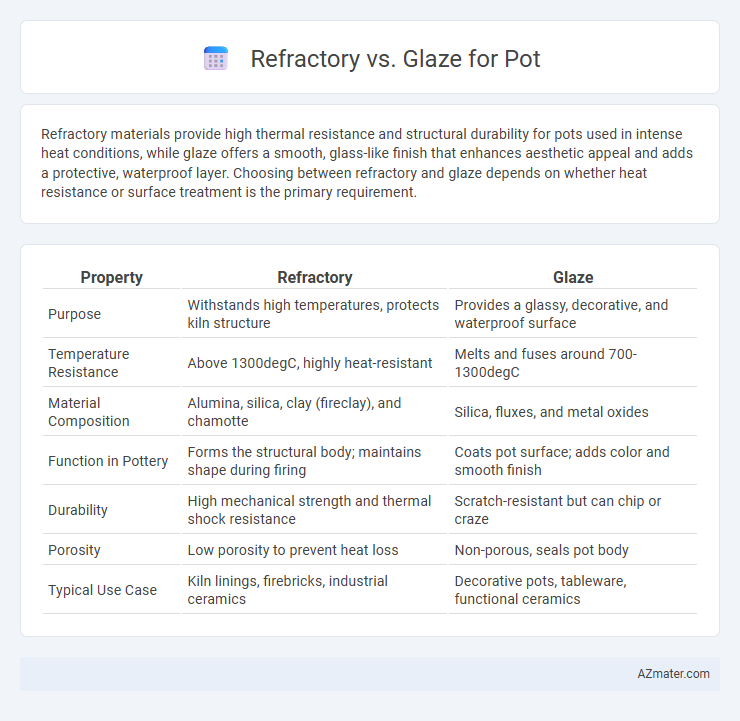Refractory materials provide high thermal resistance and structural durability for pots used in intense heat conditions, while glaze offers a smooth, glass-like finish that enhances aesthetic appeal and adds a protective, waterproof layer. Choosing between refractory and glaze depends on whether heat resistance or surface treatment is the primary requirement.
Table of Comparison
| Property | Refractory | Glaze |
|---|---|---|
| Purpose | Withstands high temperatures, protects kiln structure | Provides a glassy, decorative, and waterproof surface |
| Temperature Resistance | Above 1300degC, highly heat-resistant | Melts and fuses around 700-1300degC |
| Material Composition | Alumina, silica, clay (fireclay), and chamotte | Silica, fluxes, and metal oxides |
| Function in Pottery | Forms the structural body; maintains shape during firing | Coats pot surface; adds color and smooth finish |
| Durability | High mechanical strength and thermal shock resistance | Scratch-resistant but can chip or craze |
| Porosity | Low porosity to prevent heat loss | Non-porous, seals pot body |
| Typical Use Case | Kiln linings, firebricks, industrial ceramics | Decorative pots, tableware, functional ceramics |
Introduction to Pottery Materials
Refractory clay and glaze are fundamental materials in pottery, serving distinct purposes in the creation process. Refractory clay withstands high firing temperatures without melting or deforming, making it ideal for forming the pot's structure and durability. Glaze, a glassy coating applied to the pot's surface, enhances aesthetic appeal and provides a waterproof, chemical-resistant finish after firing.
What is Refractory in Pottery?
Refractory in pottery refers to materials that can withstand extremely high temperatures without melting or breaking down, essential for constructing kiln shelves, kiln furniture, and heat-resistant pottery. These materials are composed of compounds like alumina, silica, and fireclay, providing durability and thermal stability during firing processes. Unlike glaze, which creates a glassy, decorative, and waterproof surface on pots, refractory materials focus on structural integrity and heat resistance.
Understanding Glaze in Ceramics
Glaze in ceramics is a glassy coating fused to the surface of pottery through high-temperature firing, providing both aesthetic appeal and protection against moisture and wear. It chemically bonds with the clay body, creating a smooth, often glossy finish that enhances color and texture while sealing the porous ceramic. Unlike refractory materials designed primarily for heat resistance, glaze serves as a decorative and functional layer that improves durability and usability in everyday ceramic pots.
Key Differences: Refractory vs Glaze
Refractory materials in pottery are designed to withstand high temperatures without melting or deforming, providing structural support for kiln shelves and kiln furniture during firing. Glaze, on the other hand, is a glassy coating applied to pottery surfaces to create a smooth, decorative, and often waterproof finish after firing. The key difference lies in their function: refractory materials endure intense heat as durable supports, while glazes serve an aesthetic and functional surface treatment.
Thermal Properties: Refractory vs Glaze
Refractory materials in pots provide superior thermal resistance, maintaining structural integrity at temperatures exceeding 1,600degC, which prevents cracking during high-heat applications like kiln firing. Glazes, while enhancing surface durability and aesthetic appeal, typically withstand lower thermal ranges, often between 1,050degC and 1,300degC, and can crack or craze under extreme heat fluctuations. The thermal expansion compatibility of refractory bodies and glaze coatings is critical to prevent thermal stress, ensuring pot longevity and performance under varying thermal conditions.
Chemical Composition Comparison
Refractory materials for pots primarily consist of alumina, silica, and other oxides that provide high melting points and thermal stability, ensuring durability under extreme heat. Glazes contain a combination of silica, fluxes like sodium or potassium oxides, and alumina, which melt to form a glassy surface that enhances aesthetics and water resistance. The key chemical difference lies in refractories' focus on heat resistance through stable oxides, whereas glazes emphasize melting behavior for surface vitrification.
Functional Roles in Pottery Making
Refractory materials in pottery are designed to withstand high temperatures during kiln firing, preventing deformation or cracking by maintaining structural integrity under thermal stress. Glazes, on the other hand, serve as a functional coating that creates a vitrified, glass-like surface, enhancing the pot's durability, water resistance, and aesthetic appeal. While refractory components emphasize heat resistance and strength in the clay body, glazes optimize surface properties and finishing in pottery making.
Applications: When to Use Refractory or Glaze
Refractory materials are ideal for applications requiring high heat resistance and structural durability, such as kiln shelves, furnace linings, or fire bricks, where direct exposure to flames and thermal shock occurs. Glazes are used primarily for surface finishing on pottery to create a glass-like coating that enhances aesthetics, provides water resistance, and improves chemical durability but are not suitable for structural heat containment. Choose refractory for functional heat containment and durability, while glaze is best suited for decorative and protective surface treatment in ceramics.
Common Mistakes in Choosing Materials
Choosing between refractory and glaze materials for pots often leads to common mistakes such as overlooking the thermal shock resistance of refractory materials, which can cause cracking during rapid heating or cooling. Many also confuse glaze properties, neglecting its durability and chemical composition that affect food safety and aesthetic outcomes. Ignoring compatibility between glaze and clay body can result in defects like crazing or peeling, compromising both functionality and appearance.
Tips for Selecting the Right Material for Your Pot
When selecting the right material for your pot, consider the specific heat resistance and thermal shock properties of refractory materials, which excel in high-temperature environments such as kilns and industrial furnaces. Glazes offer aesthetic finishes and waterproof capabilities but lack the durability for extreme heat exposure. Choose refractory materials for structural strength and longevity, and opt for glazes when surface texture and appearance are the primary concerns.

Infographic: Refractory vs Glaze for Pot
 azmater.com
azmater.com